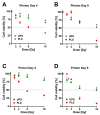Photon and Proton irradiation in Patient-derived, Three-Dimensional Soft Tissue Sarcoma Models
- PMID: 37349697
- PMCID: PMC10286352
- DOI: 10.1186/s12885-023-11013-y
Photon and Proton irradiation in Patient-derived, Three-Dimensional Soft Tissue Sarcoma Models
Abstract
Background: Despite their heterogeneity, the current standard preoperative radiotherapy regimen for localized high-grade soft tissue sarcoma (STS) follows a one fits all approach for all STS subtypes. Sarcoma patient-derived three-dimensional cell culture models represent an innovative tool to overcome challenges in clinical research enabling reproducible subtype-specific research on STS. In this pilot study, we present our methodology and preliminary results using STS patient-derived 3D cell cultures that were exposed to different doses of photon and proton radiation. Our aim was: (i) to establish a reproducible method for irradiation of STS patient-derived 3D cell cultures and (ii) to explore the differences in tumor cell viability of two different STS subtypes exposed to increasing doses of photon and proton radiation at different time points.
Methods: Two patient-derived cell cultures of untreated localized high-grade STS (an undifferentiated pleomorphic sarcoma (UPS) and a pleomorphic liposarcoma (PLS)) were exposed to a single fraction of photon or proton irradiation using doses of 0 Gy (sham irradiation), 2 Gy, 4 Gy, 8 Gy and 16 Gy. Cell viability was measured and compared to sham irradiation at two different time points (four and eight days after irradiation).
Results: The proportion of viable tumor cells four days after photon irradiation for UPS vs. PLS were significantly different with 85% vs. 65% (4 Gy), 80% vs. 50% (8 Gy) and 70% vs. 35% (16 Gy). Proton irradiation led to similar diverging viability curves between UPS vs. PLS four days after irradiation with 90% vs. 75% (4 Gy), 85% vs. 45% (8 Gy) and 80% vs. 35% (16 Gy). Photon and proton radiation displayed only minor differences in cell-killing properties within each cell culture (UPS and PLS). The cell-killing effect of radiation sustained at eight days after irradiation in both cell cultures.
Conclusions: Pronounced differences in radiosensitivity are evident among UPS and PLS 3D patient-derived sarcoma cell cultures which may reflect the clinical heterogeneity. Photon and proton radiation showed similar dose-dependent cell-killing effectiveness in both 3D cell cultures. Patient-derived 3D STS cell cultures may represent a valuable tool to enable translational studies towards individualized subtype-specific radiotherapy in patients with STS.
Keywords: Organoid; Patient-derived; Photon; Proton; Radiotherapy; Sarcoma, 3D cell culture; Soft tissue sarcoma.
© 2023. The Author(s).
Conflict of interest statement
DK received travel grants from Accuray and is a member of the advisory board for Novocure, he has no competing interest related to the presented work. The other authors declare that they have no competing interest related to the presented work.
Figures





References
-
- Soft Tissue and Bone Tumours., WHO Classification of Tumours, 5th Edition, Volume 3, 2020.
-
- Gronchi A, Miah AB, Dei Tos AP, Abecassis N, Bajpai J, Bauer S, et al. Soft tissue and visceral sarcomas: ESMO–EURACAN–GENTURIS Clinical Practice Guidelines for diagnosis, treatment and follow-up < sup>☆</sup>. Annals of Oncology. 2021;32(11):1348-65. - PubMed
-
- Deutsche Krebsgesellschaft DK. AWMF. S3-Leitlinie Adulte Weichgewebesarkome, Langversion Version 1.0, 2021. Leitlinienprogramm Onkologie. 2021.
MeSH terms
Substances
LinkOut - more resources
Full Text Sources
Medical

